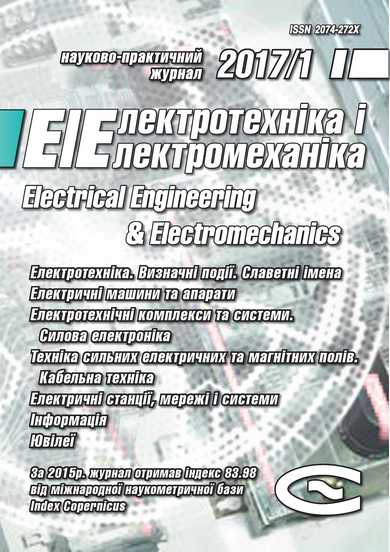STATISTICAL OPTIMIZATION OF FREQUENCY REGULATED INDUCTION ELECTRIC DRIVES WITH SCALAR CONTROL
DOI:
https://doi.org/10.20998/2074-272X.2017.1.05Keywords:
induction electric drive, frequency scalar control, stochastic load, optimal regulatorAbstract
Purpose. Working out of technique of synthesizing statistically optimal controllers of induction electric drives with frequency scalar control operating under stochastic loads. Methodology. It is shown, that one of the ways of increasing the energy efficiency of induction electric drives at random changes of loads is to create closed systems of electric drives with statistically optimal regulators that would take into account the stochastic nature of the disturbances and acted as filters of occasional high frequency fluctuations. The structure of such controls depends on the statistical characteristics of stochastic loads – correlation function and spectral density. In this mode, the minimum loss in dynamic mode with random intensive changed loads is provided by criterion of minimum mean square error of optimal parameter control. In the case of frequency controlled electric drive such a parameter is the optimum rotor flux. Results. The optimal structures of regulators of electric drives under stochastic loads according to type of random disturbances are identified. Originality. The technique of statistically optimal synthesis with feature of the expansion of a random process load on average, served as a useful signal, and high-frequency fluctuations around the average value, served as barrier, is developed. Practical value. On an example of simulation of work of the electric drive of a crusher of grain it is shown efficiency of a filtration by statically optimal regulator of the high-frequency components of random torques of load, reduction of dispersions of its outlet parameters, increase of cyclic indicators of energy efficiency of the electric drive, such as cyclic efficiency and power factor.References
1. E. Levi, M. Sokola, A. Boglietti, M. Pastorelli. Iron loss in rotor-flux oriented induction machines: identification, assessment of detuning, and compensation. IEEE Transactions on Power Electronics, 1996, vol.11, no.5, pp. 698-709. doi: 10.1109/63.535402.
2. Dymko S., Peresada S., Leidhold R. Torque control of saturated induction motors with torque per ampere ratio maximization. Proceedings of 2014 IEEE International Conference on Intelligent Energy and Power Systems, 2-6 June 2014, Kyiv, Ukraine, pp. 251-256.
3. Braslavskii I.Ya., Ishmatov Z.Sh., Plotnikov Yu.V. Energy- and resource-conserving technologies based on controllable asynchronous drives. Russian Electrical Engineering, 2004, vol.75, no.9, pp. 30-36.
4. Shurub Yu.V., Dudnyk A.O., Lavinskiy D.S. Optimization of regulators of frequency controlled induction electric drives under the stochastic loadings. Tekhnichna elektrodynamika, 2016, no.4, pp. 53-55. (Ukr).
Downloads
Published
How to Cite
Issue
Section
License
Copyright (c) 2017 Yu. V. Shurub

This work is licensed under a Creative Commons Attribution-NonCommercial 4.0 International License.
Authors who publish with this journal agree to the following terms:
1. Authors retain copyright and grant the journal right of first publication with the work simultaneously licensed under a Creative Commons Attribution License that allows others to share the work with an acknowledgement of the work's authorship and initial publication in this journal.
2. Authors are able to enter into separate, additional contractual arrangements for the non-exclusive distribution of the journal's published version of the work (e.g., post it to an institutional repository or publish it in a book), with an acknowledgement of its initial publication in this journal.
3. Authors are permitted and encouraged to post their work online (e.g., in institutional repositories or on their website) prior to and during the submission process, as it can lead to productive exchanges, as well as earlier and greater citation of published work.




